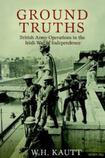
The withdrawal of the British army from Ireland began soon after the Dáil approved the Anglo-Irish Treaty, in early January 1922, and rolled on with a speed that took many people by surprise. At the end of January one of the most famous garrison posts in Dublin, Beggars Bush barracks, was handed over to the Irish Army, and by the end of February two-thirds of the British military installations in Free State territory had been evacuated. While its soldiers headed for the ports, Irish Command set out to put together an account of its campaign against the Irish Volunteers over the previous few years.
The result, the Record of the Rebellion in Ireland 1919-1921 , ran to four volumes, dealing with operations in general, the three divisional commands, law and intelligence. The general operational history written by the GHQ of Irish Command, much of it in the distinctive style of the commander-in-chief, Sir Nevil Macready, was the first to be finished, in March 1922. It was written with the express intent of providing useful guidance to commanders who might face similar situations in future, but not long after the whole record was completed, later that year, it disappeared. Odd copies surfaced from time to time in private collections, but not until 2001 was the official version finally released; this is now published in an edition with commentary supplied by Dr William Kautt.
Both the Irish and the British governments have shown extreme caution about releasing their records of the Anglo-Irish war, even when (as in the case of the celebrated Bureau of Military History witness statements) such documents were not confidential State papers in the first place. Governments, of course, are inclined, when they can get away with it, to retain if not destroy records that reflect badly on their actions or, perhaps less culpably, that might endanger people still living.
The British decision to keep this document under closure for some 80 years is puzzling. It contains no sensitive material. It will be clear to any reader that the authors were not in the business of revealing embarrassing, much less criminal, activity by the British army. Is it possible that the reason, however unlikely it may seem, might be that the army’s account showed the British state itself in a most unflattering light?
The British army’s performance in the Irish republican guerrilla campaign was disappointing. So recently a major part of the mighty coalition that had won the first World War, it had struggled to find appropriate methods to deal with small-scale irregular warfare. But it had, so it believed, been fighting with one hand tied behind its back. Most crucially, it had never been given a clear or feasible military objective by the British government, which blocked tough military measures – above all martial law – because it wanted to present the conflict as a minor police action rather than as a rebellion requiring a military response.
Throughout most of Ireland, and through most of the conflict, the army acted “in aid of the civil power”, a power of whose competence and resolve it did not have a high opinion. Its task, which it had to deduce for itself, was to restore sufficient order for the (supposed) moderate nationalist majority in Ireland to return to the “constitutional” path via free elections.
As many other armies would discover in attempting to counter insurgencies over the following century, this task was supremely difficult and perhaps impossible. The kind of numbers of troops necessary to exert close control while pursuing active operations against the rebels were never available; British battalions were always severely under strength, and contained a high proportion of raw recruits, yet the circumstances meant that there was little or no time for military training. The ill-disciplined police were outside military control, and even the Royal Navy proved oddly unco-operative.
The army’s sense of itself as a Hercules in chains comes through vividly in this narrative, which demonstrates almost as much contempt for its own government (albeit expressed in oblique terms) as for its unconventional enemies in the IRA. This may be, as the editor repeatedly suggests, enough to undermine the validity of this account as a “record” of how things really were.
It is certainly not the place to look for insights into the nature of the Irish republican movement. It will probably not surprise most readers to find that the military leaders had little understanding of the motives and character of their republican antagonists, dismissing them as criminals and persistently underestimating their military capacity. They were predictably impatient of politics. Their contemptuous placing of things they disliked in inverted commas embraced not only the “chief of staff” of the IRA but also the “truce” that ended the fighting in July 1921, and even the Treaty itself.
At the same time, though, their analysis of events and their political perception were often more nuanced than might be expected. Their complaints about the failure to establish an agreed version of the Truce were more justifiable than the editor allows. And although their endless complaints about the weakness of their political bosses can be tiresome, they surely had a vital point there. It may be true that the army did not rise very impressively to the challenge of insurgency in purely military terms, but in situations such as these it is not soldiers but politicians who have the responsibility of devising a credible overall strategy. Gen Macready himself never doubted that a “military solution” was impossible or even irrelevant; in this his vision was clearer than Lloyd George’s.
Two other sections of the Record of the Rebellion in Ireland 1919-1921 have already appeared in print, and it is good that this key part has at last been made widely accessible. The editor's additions are something of a mixed bag. Some are simple factual glosses, some slightly vague speculations, and some general disquisitions on the nature of irregular war. Unconventionally, they are set not as footnotes but in highlighted boxes within the text, where they occupy a lot of space. (Rather confusingly, though, there are also conventional endnotes.)
Apart from the mildly annoying fact that they often appear on different pages from the text they refer to, they throw into relief not just factual errors – such as the suggestion that the Civil War had already begun when this section of the record was being written – but also issues on which the editor has elected not to comment, such as the army chiefs’ assessment of public support for the IRA, or of the effectiveness of flying columns in the last six months of the conflict.
And since the editor says, reasonably enough, that the original War Office version is to be preferred to the copies in other collections, it is disappointing that he does not indicate the points in the text where the differences lie. A number of transcription errors have crept in and could give the impression that the military chiefs were not fully literate – which they certainly were.
Dr Kautt is no doubt right to stress their inaccuracy, their “wilful myopia”, pettiness and even dishonesty, though it makes the title he has chosen for this book look odd. (Of the Croke Park incident, for instance, he suggests that “there is little in this apologia to correspond with the truth”.) Even so, everyone interested in the Anglo-Irish conflict will find this unique account worth reading.









